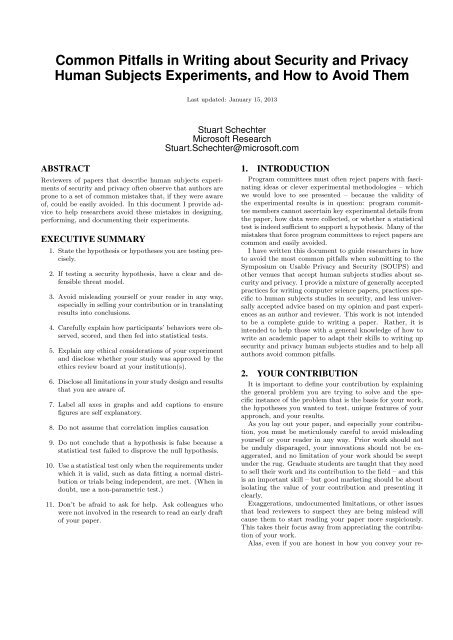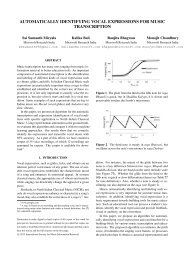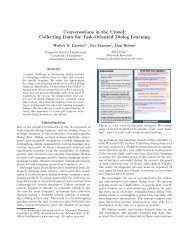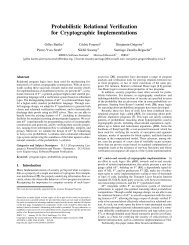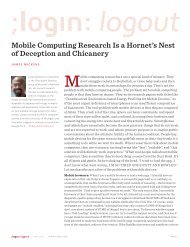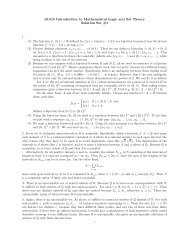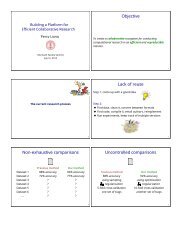PDF file - Microsoft Research
PDF file - Microsoft Research
PDF file - Microsoft Research
Create successful ePaper yourself
Turn your PDF publications into a flip-book with our unique Google optimized e-Paper software.
Common Pitfalls in Writing about Security and Privacy<br />
Human Subjects Experiments, and How to Avoid Them<br />
Last updated: January 15, 2013<br />
Stuart Schechter<br />
<strong>Microsoft</strong> <strong>Research</strong><br />
Stuart.Schechter@microsoft.com<br />
ABSTRACT<br />
Reviewers of papers that describe human subjects experiments<br />
of security and privacy often observe that authors are<br />
prone to a set of common mistakes that, if they were aware<br />
of, could be easily avoided. In this document I provide advice<br />
to help researchers avoid these mistakes in designing,<br />
performing, and documenting their experiments.<br />
EXECUTIVE SUMMARY<br />
1. State the hypothesis or hypotheses you are testing precisely.<br />
2. If testing a security hypothesis, have a clear and defensible<br />
threat model.<br />
3. Avoid misleading yourself or your reader in any way,<br />
especially in selling your contribution or in translating<br />
results into conclusions.<br />
4. Carefully explain how participants’ behaviors were observed,<br />
scored, and then fed into statistical tests.<br />
5. Explain any ethical considerations of your experiment<br />
and disclose whether your study was approved by the<br />
ethics review board at your institution(s).<br />
6. Disclose all limitations in your study design and results<br />
that you are aware of.<br />
7. Label all axes in graphs and add captions to ensure<br />
figures are self explanatory.<br />
8. Do not assume that correlation implies causation<br />
9. Do not conclude that a hypothesis is false because a<br />
statistical test failed to disprove the null hypothesis.<br />
10. Use a statistical test only when the requirements under<br />
which it is valid, such as data fitting a normal distribution<br />
or trials being independent, are met. (When in<br />
doubt, use a non-parametric test.)<br />
11. Don’t be afraid to ask for help. Ask colleagues who<br />
were not involved in the research to read an early draft<br />
of your paper.<br />
1. INTRODUCTION<br />
Program committees must often reject papers with fascinating<br />
ideas or clever experimental methodologies – which<br />
we would love to see presented – because the validity of<br />
the experimental results is in question: program committee<br />
members cannot ascertain key experimental details from<br />
the paper, how data were collected, or whether a statistical<br />
test is indeed sufficient to support a hypothesis. Many of the<br />
mistakes that force program committees to reject papers are<br />
common and easily avoided.<br />
I have written this document to guide researchers in how<br />
to avoid the most common pitfalls when submitting to the<br />
Symposium on Usable Privacy and Security (SOUPS) and<br />
other venues that accept human subjects studies about security<br />
and privacy. I provide a mixture of generally accepted<br />
practices for writing computer science papers, practices specific<br />
to human subjects studies in security, and less universally<br />
accepted advice based on my opinion and past experiences<br />
as an author and reviewer. This work is not intended<br />
to be a complete guide to writing a paper. Rather, it is<br />
intended to help those with a general knowledge of how to<br />
write an academic paper to adapt their skills to writing up<br />
security and privacy human subjects studies and to help all<br />
authors avoid common pitfalls.<br />
2. YOUR CONTRIBUTION<br />
It is important to define your contribution by explaining<br />
the general problem you are trying to solve and the specific<br />
instance of the problem that is the basis for your work,<br />
the hypotheses you wanted to test, unique features of your<br />
approach, and your results.<br />
As you lay out your paper, and especially your contribution,<br />
you must be meticulously careful to avoid misleading<br />
yourself or your reader in any way. Prior work should not<br />
be unduly disparaged, your innovations should not be exaggerated,<br />
and no limitation of your work should be swept<br />
under the rug. Graduate students are taught that they need<br />
to sell their work and its contribution to the field – and this<br />
is an important skill – but good marketing should be about<br />
isolating the value of your contribution and presenting it<br />
clearly.<br />
Exaggerations, undocumented limitations, or other issues<br />
that lead reviewers to suspect they are being mislead will<br />
cause them to start reading your paper more suspiciously.<br />
This takes their focus away from appreciating the contribution<br />
of your work.<br />
Alas, even if you are honest in how you convey your re-
search, it is exceedingly hard to determine if you have conveyed<br />
the information necessary for someone other than yourself<br />
to understand it. The best way to determine if your research<br />
will be comprehensible is to ask colleagues who were<br />
not involved in the research to read an early draft of your paper.<br />
If you are not a native-level speaker of the language in<br />
which the work is written, find a native-level speaker to point<br />
out and help remove any problems with language, spelling,<br />
or idioms.<br />
3. EXPERIMENTAL DESIGN<br />
Experiments are designed to test hypotheses. It is important<br />
that you state the hypothesis or hypotheses you are<br />
testing precisely.<br />
Your experimental design should be documented in sufficient<br />
detail to allow another researcher to replicate your experiment<br />
without consulting you for missing details. While<br />
many papers fail to reach this standard and still are accepted<br />
into top publications, you will be well served by working to<br />
ensure that your experiment is documented well enough to<br />
allow it to be replicated.<br />
3.1 What to include<br />
One way to collect the details you’ll need to present about<br />
your experiment is to imagine the chronological progression<br />
of your experiment from the perspective of your participants<br />
(noting the variations between treatment groups), your perspective<br />
as a researcher, and the perspective of anyone else<br />
involved in the conduct of the experiment (including recruiters).<br />
Often, the description of the experiment in your<br />
paper will also follow a chronological time line. Questions<br />
that you’ll want to answer in your description of the experiment<br />
should include:<br />
• What infrastructure did you use or build to facilitate<br />
your experiment?<br />
• How were participants recruited?<br />
• What incentive was provided to participate?<br />
• Where did the participants go to participate?<br />
• What were participants asked to do before, as part of,<br />
and following the experiment?<br />
• What information did participants learn along the way<br />
and how might this have influenced behaviors later on<br />
in the experiment?<br />
• If the study was a between-subjects study, how did the<br />
experience (treatment) vary between the groups?<br />
• Did the order of any tasks change for different participants?<br />
• If deception was used, explain how the deception was<br />
perpetuated at each interaction with participants and<br />
at what point the deception was revealed.<br />
To enumerate more details, examine the study from your<br />
perspective as the researcher.<br />
Detail the recruiting process and the resulting demographic<br />
makeup of the participant pool. If the participant pool does<br />
not precisely reflect the population of interest you’ll want to<br />
discuss the differences.<br />
Describe how participants were observed and how observations<br />
translated into data points used for later analysis. A<br />
surprising number of submissions fail to explain how behaviors<br />
are observed, scored, and then fed into statistical tests.<br />
A statistical test is of little value if the reviewer doesn’t<br />
know how observations were collected, how these observations<br />
were translated into numeric scores, or how these numeric<br />
scores were processed before a statistical test was applied.<br />
Along the way, you should highlight the decision points<br />
you came across in designing the experiment and explain the<br />
reasoning behind the choices you made. Own up to mistakes,<br />
especially if you have suggestions for how the methodology<br />
might have been improved. I’ve never run a study and not<br />
wished I’d designed their experiment at least slightly differently<br />
when the time came to write up the results.<br />
3.2 Ethics and participant safety<br />
Many institutions (including all U.S. universities) require<br />
human subjects experiments to be approved by an Institutional<br />
Review Board (IRB). Explain whether you or any<br />
of your collaborators work at an institution with an institutional<br />
ethics review board (IRB). Explain the process<br />
through which your experiment was approved. Regardless<br />
of whether your experiment was reviewed by an IRB, you<br />
will want to describe any potential ethical or safety risks and<br />
how you addressed them.<br />
If participants were deceived at any time during the study,<br />
you’ll want to explain the nature of the deception, how deception<br />
impacted each step of the process from recruiting all<br />
the way to behavior measurements, and when the deception<br />
was revealed to participants. Indicate whether participants<br />
were given the option to withdraw their consent to participate<br />
in the study after the true purpose of the study had<br />
been revealed (which is highly recommended). If participants<br />
were never informed of the deception, you will need to<br />
disclose this as well. (Failing to reveal the use of deception<br />
is quite controversial. See, for example, this paper.)<br />
Indicate what steps you took to detect if participants<br />
might be harmed by your experiment (if any).<br />
If you have are planning to run a deception study and<br />
would like to use a pre-packaged infrastructure that is carefully<br />
designed to detect participants’ perceptions of harm,<br />
and allow participants who feel harmed to withdraw their<br />
consent to participate, please consider contacting The Ethical<br />
<strong>Research</strong> Project the use their survey (disclosure: I am<br />
part of that project.)<br />
3.3 Supplementary documentation<br />
No matter how hard you try, you may not be able to fit<br />
every detail of your experiment – such as the precise wording<br />
of every question posed to participants – in the body of the<br />
paper. To assist readers who may have questions that you<br />
could not be expected to anticipate or that fall outside the<br />
stated contribution of your work, consider attaching your<br />
study materials into an appendix at the end of your paper.<br />
Appendices are not a substitute for carefully detailing your<br />
methodology in the paper, as reviewers are neither required<br />
nor expected to read them. You must still ensure that you<br />
have explained all of the details essential the the validity of<br />
your experimental goals, methodology, and conclusions.
4. SPECIAL CONSIDERATIONS:<br />
EXPERIMENTS INVOLVING<br />
SIMULATED ATTACKS<br />
Experiments involving behavior in response to privacy and<br />
security threats warrant extra consideration in areas that<br />
may be less important when writing up other HCI experiments.<br />
4.1 Have a clear threat model<br />
If testing security behavior in response to an attack, clearly<br />
explain the assumptions made about the information, capabilities,<br />
and resources available to an attacker. These assumptions<br />
are your threat model. A common failing in papers<br />
is to fail to document or justify the assumptions that<br />
make up your threat model. Document how any attack you<br />
may simulate is similar to, and different from, a real attack.<br />
4.2 Avoid bias in favor of your own system<br />
If you are testing a system of your own design, beware of<br />
the potential or appearance of bias when designing a threat<br />
model and experimental design. An attacker will have more<br />
incentive to break your system than you do. Reviewers may<br />
look at an attack you tested against and believe, rightly or<br />
wrongly, that they could have designed more effective attacks.<br />
One way to remove bias is to identify third parties<br />
with both the talent and incentive to develop the best possible<br />
attack against the system you have built. We’ve even<br />
considered holding contests to identify the most effective attack<br />
against which to test our systems.<br />
4.3 Address ecological validity<br />
There are many potential reasons why participants in a<br />
research study may not behave as they would in the real-life<br />
situation that your experiment is designed to emulate.<br />
Ecological validity is especially challenging when designing<br />
experiments of security and privacy behavior because,<br />
for most of the interesting scenarios to study, security or<br />
privacy will not be the primary goal of the individual. Furthermore,<br />
not completing the primary task may also have<br />
risks and consequences. Simulating the forces motivating<br />
a user’s drive to complete a primary task and response to<br />
potential risks is challenging, and so extra attention to ecological<br />
validity is warranted as you design and document<br />
your experiment.<br />
Questions you’ll want to address include whether participants<br />
knew the study was about security or that the researchers<br />
study security. If they did, would this have led<br />
them to pay more attention to security? Did participants<br />
believe that they would be negatively impacted if they exhibited<br />
an insecure behavior in the same way that they would<br />
in real life? Did participants believe they had something<br />
to lose if they failed to complete a task because they could<br />
not do so securely or did not know how to do so securely?<br />
Have you considered the potential for users’ behaviors to become<br />
habituated in a manner that could negatively impact<br />
security or usability?<br />
5. DISCLOSE LIMITATIONS<br />
Be up front and disclose all the limitations of your study<br />
design, participant demographics, statistical tests, and other<br />
methodological issues.<br />
One of the goals of peer review is to keep papers with<br />
misleading or fundamentally flawed results from receiving<br />
additional credibility through publication, leading others to<br />
cite flawed conclusions as fact. Reviewers will be looking for<br />
undisclosed methodological limitations, overstated results,<br />
or other content that may mislead a reader. Ensuring that<br />
readers can correctly identify the scientific implications of<br />
your study is your job first, and reviewers second, and so<br />
the better you can show that you’ve done it the better reviewers<br />
will feel about your work. Reviewers will be less<br />
likely to critique your study design if they see that you are<br />
aware of the limitations of your work and have fully disclosed<br />
them. By showing that you’ve already looked at your own<br />
experiment with a critical eye, you allow your reviewers to<br />
focus more on evaluating the implications of your findings<br />
and less on searching for flaws that they suspect may be<br />
hiding under the covers.<br />
Your discussion of limitations may be placed into its own<br />
subsection of your methodology section, results, or discussion<br />
sections. You may even want to promote limitations to<br />
an independent section of the paper.<br />
6. PRESENTING RESULTS<br />
For each test, remind the reader of the hypothesis to be<br />
tested, present the data used to test the hypothesis, explain<br />
your choice of statistical test, and then present the result of<br />
that test.<br />
6.1 Tables and figures<br />
Clearly label the rows and columns of tables and the axes<br />
of figures. Make sure the title or caption precisely describes<br />
what the contents of the table or figure represent. A surprising<br />
number of papers contains axes that are not labeled<br />
and graphs for which one cannot determine what data are<br />
being plotted.<br />
6.2 Statistical validity<br />
There are two common statistical errors that we<br />
on the SOUPS committee see every year. First, authors<br />
often describe a failure to disprove the null<br />
hypothesis as an indication that the null hypothesis<br />
is true. In other words, we see authors interpret a<br />
statistical test score where p > 0.05 as evidence that the<br />
hypothesis being tested is false, when it’s entirely possible<br />
that a larger sample might have yielded p < 0.05. Rather,<br />
failure to disprove the null hypothesis simply means that<br />
there was not enough evidence, given the size of the sample<br />
and the random outcomes, to prove the null hypothesis<br />
to be false. Failure to prove something is false does not<br />
mean it is true. The only way one could ever prove that<br />
no difference existed between two populations would be to<br />
test, and obtain a perfect measurement, of every member<br />
of both populations, rendering statistical tests unnecessary.<br />
Otherwise, the best you can do is to measure the statistical<br />
certainty that the difference between two populations is<br />
within a certain bound.<br />
I’ve seen experts describe the results of two experiments as<br />
conflicting when one was able to show a statistical difference<br />
between the two groups and the other was not. In some<br />
cases, both studies might find the exact same difference, but<br />
one study may have had the larger sample. In other cases,<br />
luck caused one study to just pass a significance threshold<br />
(say p = 0.48) whereas another just failed to meet it (p =
0.52). In this case, the results would be nearly identical with<br />
the exception that an arbitrarily chosen threshold lies in the<br />
tiny space between them.<br />
The second common mistake is to use more than<br />
one data point per participant in a statistical test<br />
that assumes data points are independent. The very<br />
fact that two data points come from a single participant<br />
means they are not independent.<br />
As the number of statistical tests used to test one or more<br />
hypotheses grows, so does the chance that one will reach<br />
your significance threshold due to random chance. You may<br />
want to correct for multiple testing. See, for example, the<br />
Wikipedia entry on Multiple Comparisons.<br />
An example of this mistake is to ask 10 participants 10<br />
questions, and then feed the 100 responses into a statistical<br />
test. The statistical test will produce a p value as it would if<br />
there were actually 1 question asked of 100 participants. If<br />
it isn’t already clear to you why this is a problem, imagine<br />
that one were to ask 50 questions about statistics of one<br />
man and one woman. The statistical test has 50 samples for<br />
men and 50 samples for women. Let’s say the man has no<br />
knowledge of statistics, and gets all 50 questions wrong. The<br />
woman gets them all right. Misled to believe that it had 50<br />
independent trials from both men and women, the statistical<br />
test would indicate that women are better at statistics than<br />
men with a p value far below 0.01–a significant result! It is<br />
hopefully intuitively obvious that one cannot make such a<br />
strong conclusion about two populations by sampling only<br />
one member from each.<br />
There are a number of ways to run statistical tests when<br />
you have multiple data points from the same participant.<br />
One simple one is to take a summary statistic for each participant<br />
and run the statistical test on the summary statistic.<br />
A student t-test is, after all, a test for comparing students’<br />
scores on exams that have many questions. It is designed<br />
to be used for a summary statistic, their test score, over a<br />
large enough number of questions that the score fits a normal<br />
distribution.<br />
Speaking of t-tests, and other statistical tests that rely<br />
on scores to be drawn from a normal distribution, you will<br />
want to show that your scores indeed appear to resemble a<br />
normal distribution if you are using these tests. At the very<br />
least, explain why you believe the scores should fall into a<br />
normal distribution. Better yet, use a non-parametric test<br />
when there is any doubt that the distribution is normal. If<br />
you have any question about the right test to use or how to<br />
use it, don’t be afraid to ask for help. If you don’t have a<br />
knowledgeable colleague handy, a number of helpful online<br />
guides can be found by searching on the phrase “choosing<br />
the right statistical test”.<br />
As the number of statistical tests used to test one or more<br />
hypotheses grows, so does the chance that one will reach<br />
your significance threshold due to random chance. Be sure<br />
to correct for multiple comparisons. See, for example, the<br />
Wikipedia entry on Multiple Comparisons. This is easy to<br />
do but, again, a surprising number of papers have numerous<br />
statistical tests and no correction for multiple comparisons.<br />
After completing both the experiments and analyses required<br />
to test a hypothesis, you’ll want to discuss your results.<br />
In doing so, be careful not to jump to conclusions<br />
beyond those supported by your hypothesis and tests. Speculation<br />
about possible implications that could be tested with<br />
future work should be presented as such.<br />
7. CITING RELATED WORK<br />
To find related work perform web searches on key terms,<br />
scour the HCISEC bibliography and the proceedings of SOUPS,<br />
CHI, the IEEE Symposium on Security and Privacy (Oakland),<br />
USENIX Security, ACM CCS, and NDSS. As you<br />
look at related work, note key terms that may be useful for<br />
searching for other related work. You may also want to consult<br />
with other researchers who have written work in an area<br />
closely related to yours.<br />
7.1 Where does related work go?<br />
The HCI community mostly adheres to a convention of<br />
presenting related work before experiments to ensure that<br />
the reader has all necessary background information before<br />
reading about the experimental methodology. This convention<br />
exists, in part, because may experiments build on the<br />
methodology of prior experiments and so much of the related<br />
work is germane to the experimental design.<br />
The security community mostly adheres to a convention<br />
of presenting related work after experiments and results are<br />
presented. This convention makes sense when much of the<br />
related work you may want to cite is not needed to motivate<br />
or provide background on your experiment. When this is<br />
the case, the related work may bog down a reader who is<br />
interested in getting to the details of your experiment and<br />
would prefer to understand the broader context later. If<br />
you follow this convention, you may need to cite some papers<br />
twice: first in an introductory section to motivate or provide<br />
essential background and later, after your experiment and<br />
results have been presented, to put your work in broader<br />
context.<br />
Either convention is accepted at SOUPS and so you should<br />
choose the convention that works best for your paper.<br />
7.2 Citation etiquette<br />
Wherever you cite related work, make sure citation numbers<br />
server as an essential supplement to more descriptive<br />
text that describes the work you are citing, and not a replacement<br />
for it. In other words, do not say “[42] presents<br />
an experimental methodology for testing the obsessiveness<br />
of paper reviewers” but instead say “Zaphod Beeblebrox et<br />
al. developed one of the first experimental methods for testing<br />
the obsessiveness of paper reviewers [42].” By so doing,<br />
you’ll help familiarize your reader with the names of those<br />
working in the field, your paper will read more smoothly,<br />
and those familiar with the literature won’t have to flip pages<br />
forward and backward to identify which work you are citing.<br />
Providing citation context will also help you avoid making<br />
the mistake of citing multiple works with one long string<br />
of citation numbers, such as “[59,71,72,78,84]”. Such bulk<br />
citations provide inadequate clues to the reader about what<br />
each paper is about, its contribution to the field, and its<br />
relation to your work. If work is related enough to cite, it’s<br />
usually related enough to warrant some explanation.<br />
Citing tenuously related work to increase the reference<br />
count will not earn points with reviewers or excuse the absence<br />
of key related work that has been overlooked. While<br />
there is no prescribed number of references, expect warning<br />
bells to go off in reviewers’ minds if you have fewer than ten<br />
citations or if more than a quarter of citations are to your<br />
own work.<br />
8. ACKNOWLEDGEMENTS
Assuming you received help along the way, your paper<br />
should have an acknowledgements section, though this should<br />
not be submitted during review if your paper is anonymized.<br />
I am grateful to Lorrie Cranor and Andrew Patrick for encouraging<br />
me to write this article, as well as their comments,<br />
corrections, and suggestions along the way. I am grateful to<br />
Rachna Dhamija who helped me navigate my transition to<br />
working in, and writing about, human subjects experiments<br />
in security and privacy. Adam Shostack provided additional<br />
valuable feedback.


